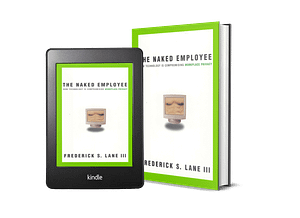“Abandon Rights, All Ye Who Enter Here.” You won’t find those words posted above the doors of any workplace. But they might as well be engraved there in stone.
You won’t find those words posted above the doors of any workplace. But they might as well be engraved there in stone.
Employers are increasingly monitoring workers, aided by technological snooping devices and a culture that tacitly encourages their use. If your company possesses the tools and the desire to peer through the windows of your life–and it probably does–you may discover that you are indeed “naked.” No Employee Bill of Rights exists to defend you. Can you protect yourself against intrusion? Yes, by arming yourself with the facts you will find in this book.
A probing look at the social, legal, and moral implications of many types of employee monitoring, The Naked Employee tackles this controversial issue from all angles:
- What are the boundaries of employee privacy?
- Who is entitled to draw them?
- What investigative and surveillance technologies exist?
- How prevalent are they?
Frederick Lane, a nationally recognized expert on law and technology, scrutinizes these matters and reveals their potential misuses. He includes dozens of fascinating examples that raise urgent questions about what can reasonably be expected from employers and employees. For example, several major companies–including Adidas, Samsonite, and Levi Strauss–have funded research involving the concept of “smart clothing”–uniforms that can track an employee’s health, habits, location…and conceivably much more.
Lane also looks at the economic and judicial challenges that drive employers to place their employees under the microscope. It is estimated that computer game-playing costs employers $50 billion a year in lost time and productivity. And the fact that companies have fired employees for sending pornography or offensive messages by company e-mail–a roster that includes Dow Chemical, Xerox, Edward Jones & Co., and The New York Times–demonstrates that businesses are taking their responsibilities seriously.
At the same time, Lane debates whether the workplace is well served by emerging technologies and policies that evoke George Orwell’s 1984. As a condition of employment, did you take a personality test that asks the types of questions forbidden by Title VII? As a health care professional or food service worker, would you agree to wear an infrared badge that beeps and flashes when you don’t wach your hands at prescribed intervals? Will all of us soon carry “smart cards” that trace our every movement at work?
In today’s security-conscious climate, stepped-up surveillance methods have become increasingly common. But what lines can and can’t be crossed? Weighing the rights of the individual against the needs of the organization, The Naked Employee will fuel a much-needed debate on a thought-provoking subject that affects you and everyone in the workplace.
Reviews …
Reading Lane’s book is enough to make any employee paranoid. The attorney and author of Obscene Profits relentlessly lays out the many and varied ways employers legally spy on employees. Web surfing? Workers are being watched. E-mail? That, too. From video cameras to ID cards to background checks, employees’ lives are basically open books to whoever is paying their salary. Lane’s style is more clinical than impassioned, laying out the hard facts instead of editorializing. But readers may wish he would rant a bit more about all this 1984-style surveillance. His subjects range from computer forensics (whatever you delete isn’t really deleted) to the routine monitoring of communications (“roughly one-half of all employers in this country periodically review their employees’ e-mails”). To his credit, Lane does sum the book up with a defense of workplace privacy, urging Congress to get with the times. Without better federal legislation, he writes, this “intrusive examination of how we live our lives” is bound to expand into every area of our existence. — Publishers Weekly
“…a fact packed, eye-opening summary of several technological advances in workplace monitoring of employee behavior…” — Library Journal
“offers a highly readable and informative explanation of the significant erosions in workplace privacy” — Privacy and American Business, Volume 10, Number 7
